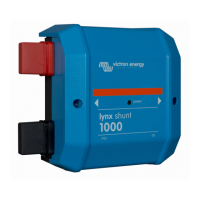
Do you have a question about the Victron energy Lynx Shunt VE.Can and is the answer not in the manual?
| Model | Lynx Shunt VE.Can |
|---|---|
| Communication | VE.Can |
| Current Rating | 1000 A |
| Current Measurement Range | ±1000 A |
| Enclosure Material | Plastic |
| Type | Shunt |
| Voltage Range | 8-70V |
| Battery Voltage | 12/24/48V |
| Operating Temperature | -40 to +60 °C |
Safety warnings for the Lynx Distribution System, emphasizing disconnecting power before working on busbars.
Guidelines for storing the product, including environmental conditions and temperature limits.
Overview of the Lynx Shunt VE.Can, its components, and connectivity to GX devices.
Information on using a GX device to monitor and manage the Lynx Shunt VE.Can.
Details about the optional temperature sensor for measuring battery temperature.
Information about the VictronConnect App for device management.
Description of the Lynx Distribution System modules and their functions.
Diagram showing internal components and connections of the Lynx Shunt VE.Can.
Information about the main system fuse, its monitoring, and alarm indication.
Explanation of the battery monitor function and data readout via GX device or VRM portal.
Details on the alarm relay, its programmable parameters, and potential uses.
How the Lynx Shunt VE.Can communicates with GX devices and the VRM portal.
Establishing communication with a NMEA 2000 network using the Lynx Shunt VE.Can.
How to design a DC distribution system using Lynx modules.
Instructions for connecting different Lynx modules together to form a system.
Proper orientation and connection logic for Lynx modules in a system for accurate state of charge calculation.
Example configuration of a Lynx system including Shunt, Power In, Distributor, and batteries.
Guidelines for sizing Lynx system components based on power requirements.
Information on current ratings for Lynx Distributor, Lynx Shunt VE.Can, and Lynx Power In modules.
Details about the main fuse space in the Lynx VE.Can and recommended fuse types and ratings.
Guidance on selecting appropriate cables and wiring for the Lynx Shunt VE.Can based on current ratings.
Instructions for making mechanical connections between Lynx modules.
Information and steps for making electrical connections to the Lynx Shunt VE.Can.
Guide to configuring settings for the Lynx Shunt VE.Can via a GX device.
Steps for commissioning the Lynx Shunt VE.Can, including cable checks, polarity, and battery charging.
How to set the battery capacity (Ah) for accurate monitoring.
Setting the voltage threshold to determine when the battery is considered fully charged.
Defining the tail current threshold to confirm full charge status.
Setting the time duration for meeting charged voltage and tail current criteria for full charge.
Setting the Peukert exponent based on battery specifications for accurate capacity calculation.
Adjusting charge efficiency settings to account for battery charging losses.
Setting a current threshold to prevent errors when the battery monitor reads zero current.
Configuring the time window for averaging battery monitoring data.
How to manually synchronize the State of Charge (SoC) to 100%.
Performing zero current calibration to ensure accurate readings when no current is flowing.
Common problems related to cabling and connections, including torque and crimping issues.
Troubleshooting steps for issues related to the main fuse, such as blown fuses or incorrect ratings.
Diagnosing and resolving common problems with the battery monitor functionality.
Troubleshooting common problems related to GX device communication and configuration.